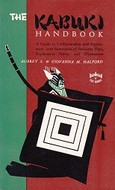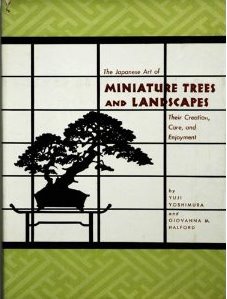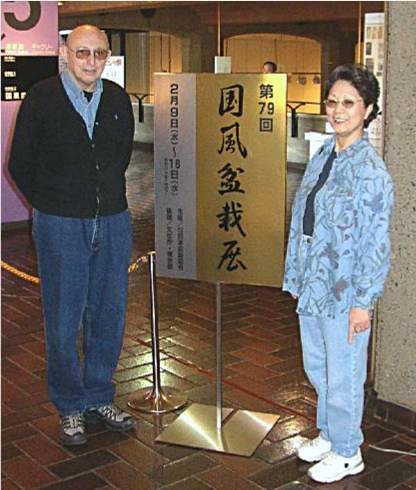| 1 |
1981 -- Donald G. Sanborn passed away. (Originally from Massachusetts, he
lived most of his life in China and approximately 30 years in Japan. He was a supplier for numerous bonsai
nurseries throughout the world. Sanborn Shopping Service advertised in Bonsai Magazine
since at least the June 1971 issue, pg. 7 and was a contributor to the BCI '72 Congress Auction. Donald
was associated with Kyokuyo Boeki Co., Ltd. since at least 1972 for pot, book, and tool orders until Dec. 15,
1977 when he switched over to Estonia, Inc. in Tokyo.) [Donald would be one of two persons to whom The Japanese Art of Stone Appreciation: Suiseki and its Use with Bonsai by Covello and Yujimura was dedicated in 1984.] (Valavanis, William N. "Through the Pine Needles," International Bonsai, Autumn/81, pg. 3; "Announcement," Bonsai Magazine, BCI, Vol. XVII, No. 4, May 1978, pg. 132; "Donors to 'Bonsai Magazine'," BCI, Vol. XI, No. 7, September 1972, pg. 12) 1998 -- Hideo "Leroy" Fujii died in Phoenix, AZ at age 73 while on the way home with other members from a demonstration he gave as part of the Phoenix Bonsai Society's display on this last day of the Arizona State Fair. (A co-founding member of the Phoenix Bonsai Society (1962) and its sensei for 28-1/2 years, Leroy was a quiet-spoken local bonsai master who was preparing to finally receive national exposure at the ABS Symposium in Tucson in late April/early May, 1999. Transforming nondescript nursery stock trees at club meetings into definite bonsai, he preferred that his students work hands-on their own trees to gain experience. He had been a landscaper around the Valley of the Sun for four decades and many homes still bore his distinctive mark of full-grown trees with distinct and classic foliage layers. Leroy's life, as well as that of club founder Paul Matsusaki and long-time honorary teacher John Naka, was told in the Nov. 1997 work, Designing Dwarfs in the Desert.) 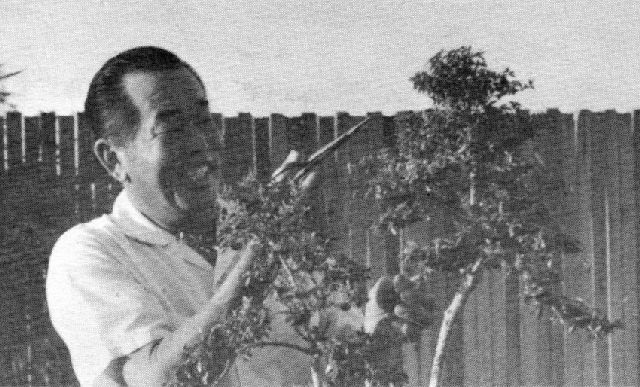
(LeRoy
[sic]
Fujii, Phoenix Bonsai Society Yearbook 1972-73, pg. 4) 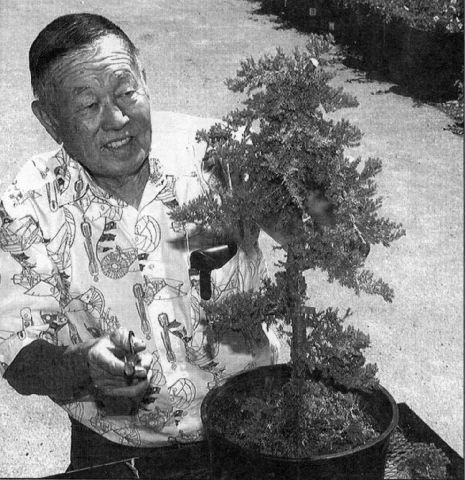
"After several minutes and lots of clipping, [Bonsai artist Leroy] Fujii
presents his finished product [from a Japanese juniper tree]."
("In Memoriam" by RJB (uncredited), Bonsai Journal, ABS, Vol. 32, No. 4, Winter 1998, pg.
152) SEE ALSO: Apr 4
(The Arizona Republic, April 12, 1996, pg. 8, photo by Charles Krejcsi) 2013 -- Influential Central and South American teacher Jorge Lucero died. ("In Memory of Jorge Lucio Lucero", found in response to private message from Alejandro Bedini G. to RJB on Facebook, 11 Feb 2014, "i heard Mr. Jorge Lucero has left Us. Do you know about that?") SEE ALSO: Jul 1, Sep 22 |
|||
| 2 |
1914 -- Giovanna Mary Durst was born in Florence, Italy. Her father was an
artist and ran a small shop near the Ponte Vecchio. [Giovanna ("Vanna") would grow up in Italy but go to
high school at St. Mary's, Calne in Wiltshire, England before attending Oxford University where she would study
Italian and French at St. Anne's College. She would meet Aubrey
Seymour Halford, who'd be studying the same languages at
Magdalen College. They
would become engaged soon after and on graduating he would join the Foreign
Office as Third Secretary in 1937 and she would join MI6. They
would marry on September 7, 1939, just four days after
war was declared.] [Aubrey S. Halford, CMG, CVO, MA was born in Birmingham on December 15, a motor manufacturing engineer's son of manifest ability. Aubrey would win a scholarship to King Edward VI School, Birmingham, and in due course read Modern Languages at Magdalen College. Serving in the Middle East, North Africa, and Rome during the war, the couple would welcome their first two sons in 1943 and 1944. A third son would be born in London in 1947.] [The year after the couple welcomed their only daughter in 1952, they would be stationed in Japan for two years. (The two older sons would be away at boarding school in England as wards of Giovanna's parents. Education would be very important to the Halfords and at that time all diplomat children would go to boarding schools.) Thus, right after the post-war Allied occupation of the islands, the Halfords would find themselves enchanted by ancient Japanese customs, and go on to write and publish The Kabuki Handbook: A Guide to Understanding and Appreciation, with Summaries of Favourite Plays, Explanatory Notes and Illustrations (Rutland, VT: Charles E. Tuttle Company; 1956; reissued 1998). Giovanna would do the illustrations in that book herself. She would be a wonderful water colour artist and paint a record of all the places she loved. Also while in Japan, she would study at the Kofu-en for two years under bonsai master Yuji Yoshimura, complete the most advanced course, and assist him in the writing of The Japanese Art of Miniature Trees and Landscapes (Tuttle; 1957; reissued 1996). She would bring to the writing of the book the ability to anticipate the Western reader's questions and problems. While there had been a few earlier books in English by this time, this would be the first really comprehensive and practical work on the subject. It would be received with excitement by those who were eager to learn classical bonsai. (Forty-three years later, the thirty-seventh printing would be made of what some have referred to as the "Bonsai Bible in English" and which still provides valuable information to both novice and experienced enthusiasts. Both of her books would remain continuously in print, the Kabuki Handbook only recently falling out.) During their stay in Japan the couple would be given numerous gifts with which Giovanna would decorate their homes -- kakemono (wall hangings), prints, ornaments, bowls, fans, dolls, etc. Japan would be a special place for them and they would be very happy there, although missing her two older sons terribly.] [The family would be reunited in Libya in 1955, and go on to Kuwait in 1957 and Munich in 1960. While there, the first visit by a Kabuki troupe to the West would occur in Berlin. The couple would travel the roughly 500 km (300 miles) north to Berlin to greet the actors, and the couple's colleagues would be greatly surprised when they learned that they were "the" Halfords who had written the Kabuki Handbook. In 1964, with his children's agreement, Aubrey would append MacLeod to their surname. About this time the couple would buy a house on the Isle of Harris where Giovanna would create a beautiful garden and cherish her bonsai which would always be the centrepiece of a festive meal. Finally, Aubrey would serve as HM's Ambassador to Iceland beginning in 1966. They would move to Edinburgh where he would work for the Scottish Council Development and Industry from 1970 until 1979. Aubrey would become a director of Scottish Opera in 1971 and would remain so until he retired. Giovanna would be the language coach for Scottish Opera for a number of years. In 1979 they would move to Harris permanently.] 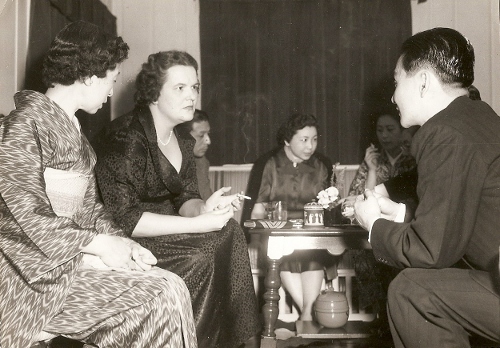
"One of my favourite photographs of my mother, it just happens to be in Japan so that makes it a suitable
choice. I don't know who she was talking to with an interpreter by her side but the photo conveys her ability to listen and be interested, essential qualities in a diplomat!" (Photo courtesy of Mary-Bess Halford)
|
|||
| 3 |
1985 -- Saburō Katō was presented with the Ranjuhosho decoration by Japanese
Prime Minister Nakasone. The award is given to
those who make exemplary contributions to the development of culture or international goodwill.
("President's Message" by Jean C. Smith, Bonsai Magazine,
BCI, March/April 1986, pg. 20) SEE ALSO: Apr 19, Oct 15, Nov 20
2001 -- The first annual Circle of Sensei Awards were presented by the Golden State Bonsai Federation. The initial group of individuals so honored consisted of Harry Hirao, Mas Imazumi, and John Y. Naka. These respected instructors have over 100 years of total teaching experience among them. ("First Recipients Honored at Convention XXIV" by Sherwin Amimoto, Golden Statements, GSBF, Vol. XXV, No. 1, January/February 2002, pp. 18-19) SEE ALSO: Jan 1, Mar 12, Oct 1, Oct 27, Dec 24, Dec 28 2001 -- Bonsai master Hideo Kato died at age 83. 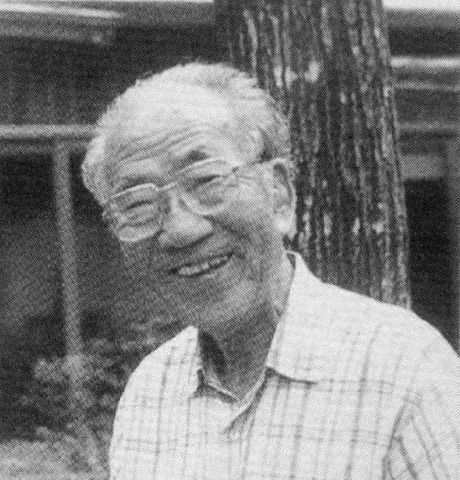
("Hideo Kato," Bonsai Magazine, BCI, Vol. 41, No. 1, January/February 2002, pg. 5)
2004 -- Tokyo's Showa Kinen Park, 444 acres of land that until 1977 was the U.S. military's Tachikawa Air Base about 10 miles from Yokota Air Base in Tachikawa, opened Japan's first government-sponsored bonsai garden in an effort to draw interest in this ancient art form. The bonsai garden showcases 61 trees, all donated, many national competition award winners. The oldest tree in the collection is 300 years old. Nestled on the north end of the park's 15-acre Japanese garden area, the bonsai showcase exhibits the plants in a mostly outdoor setting allowing visitors to get close and contemplate the trees' shapes against the backdrop of the park's traditional buildings and landscaping. "The special thing about bonsai is they change; they have more [character] as time passes," said Yushou Yabe, one of the park's two full-time bonsai caretakers. Through the care or observation of a bonsai plant, enthusiasts say, one experiences all of the seasons and is brought closer to nature. (Chandler, Stacy "Tokyo garden displays the best of Japan's miniature bonsai trees," Stars and Stripes Scene, Sunday, December 19, 2004, http://www.estripes.com/article.asp?section=140&article=26314&archive=true) 2017 -- The "Amy Liang Bonsai Museum" in Taipei, Taiwan was officially opened. The "Purple Garden" at her 2.2 acre yard and suburban home is segmented into four areas, with the main display of her personal collection of about 500 bonsai trees in some 100 species, a beautiful presentation of her shohin bonsai -- a challenge to keep them watered in the hot climate -- and an upper deck with tropical trees. A collection of viewing and scholar stones, pots, and other objects can be seen in cases inside the museum's gift shop. Her prominent gynecologist/obstetrician husband and five daughters helped the 1,200 guests during the day, and later in the early evening Amy hosted a private dinner party for 380 of her friends and family from 26 countries. Singers and dancers added to the festivities. There were so many people in the large room that there were remote TVs set up throughout so guests could enjoy the festivities as they dined on a special delicious meal. The occasion also saw the launch of her newest and 11th book, The Revelations of Bonsai: 50-Year Milestone of Amy Liang and Her Bonsai Journey. [Amy would also arrange for four buses to take her guests to Taichung for the next day's opening of the BCI 2017 and 14th ASPAC Bonsai Convention three hours away.] ("Amy Liang Bonsai Museum," Bonsai Empire, which includes a four-and-a-half minute video with an intrumental soundtrack; "Amy Liang Bonsai Museum Opening - And New Book Release," Valavanis Blog, November 4, 2017; "Amy Liang Bonsai Museum - Small, Shohin & Mame Bonsai," Valavanis Blog, November 5, 2017; "A Legendary Bonsai Master and Her Museum" by Billy Shyu, Nspirement.com, November 8, 2017) SEE ALSO: May 20 |
|||
| 4 |
1937 -- Peter Aradi was born in Budapest, Hungary. [He would graduate from
engineering college in 1956 -- and also participate in the
Hungarian Revolution that year. He
would escape from Hungary and be a refugee in Austria from 1956 to 1957, and then emigrate
to the U.S. Peter would serve in the U.S. Air Force as a photographer from 1958 to 1966. He would work for the
Associated Press for 17 days during the
1964 Tokyo [Late] Summer Olympics. Peter would marry
his wife, Shigemi, during that time. Returning to the States and finding the competition in photography brutal
in New York, he turned to computers instead for a living. Peter would go to work for IBM and AT&T before
joining American Airlines from 1968 to 1993. (Occasionally he would return to photography as a hobby,
especially after retirement.) Based in Tulsa, OK from 1973 through 2006, he would be an Adjunct Instructor/Professor
at various area universities and colleges from 1993 to 2003. The couple would raise two sons. [Peter would become interested in Japanese art in 1959 while in Hawaii. He would be exposed to bonsai and suiseki while in Japan, and once his work-connected travels became manageable, he would start a bonsai collection in 1977 and become a student of Shig Miya of Los Angeles. Pat Coen, a nationally prominent stone collector from Tulsa would introduce him to viewing stones. Peter's long-time interest in Japanese art, aesthetics and history helped him progress quickly, as would his frequent visits to bonsai conventions, nurseries and Japan. Artist-teachers Bill Valavanis and Sean Smith would also be very influential in his development. A Buddhist background and practice was the foundation upon which this all would grow. [Peter's six-part series of articles "Visiting With the Masters" would be published in the American Bonsai Society's Journal between 2000 and 2002. (Three other articles by Peter would be published in the Journal between 1997 and 1999.) His article "Gems of bonsai and saikei at the 1964 Olympic Games" would be published at the beginning of 2003 in International Bonsai magazine. The two-part article "A Tale of Two Cities -- Comparing Viewing Stone Shows in Shanghai, China and Kyoto, Japan" would see print in that periodical the following year. He would also give presentations before various bonsai clubs on the topic of Japanese and Chinese viewing stones, illustrating them with specimens from his own collection. (A handful of Japan-related topics would be presented over the years to non-bonsai groups as well.) A stay in Kyoto, Japan would be followed by a return to Tulsa in August 2003, and then a move to San Antonio, TX three years later. He would visit the Peoples Republic of China twice and Taiwan once. On their first trip to the PRC the couple would be honored at a banquet by Tsinghua University, Beijing, and be invited as guests to the First International Duo Lung Viewing Stone Symposium and Exhibit in Shanghai (2003). They would also visit Suzhou, the home of the most famous scholar/literati style gardens in China, that year and in 2005. A collaboration with Alan Walker in Chinese and English, "Contemporary Stone Appreciation," would be published in the first issue of Shanghai's Global Bonsai and Stone Collection in 2005. Shigemi and Peter would celebrate their 50th wedding anniversary in Kyoto in 2014. All in all he probably would make about 30 trips to Japan, including business, family occasions and vacations. [By 2015 Peter would be completely retired and no longer write or give presentations. James Greaves of Santa Monica, CA, would have established an American Viewing Stone Resource Center over two decades earlier and it would now become part of The Huntington Library, San Marino, CA. Jim would be named its first curator. He would acquire the most important stones and books from Peter's collection and donate them to the Library. About 95% of Peter's collection would be bought by Jim and two local San Antonio collectors. Peter's selected papers would be edited and they would also go to the Huntington Library.] (Facebook personal info, https://www.facebook.com/amszterpeter/about; The Indices 2004; posting on Internet Bonsai Club, Aug. 22, 2009, Ling Bi Wen Stone Appreciation; personal email with detailed CV to RJB, June 28 and July 1, 2015; personal email to RJB, March 3, 2016; Facebook posting on May 28, 2017.) SEE ALSO: Sep 3, Oct 10 2022 -- Long-time San Francisco area and beyond bonsai teacher Johnny Uchida died at about age 87. (Yoneo Uchida was born in Kagoshima Prefecture, near the southern tip of Japan. "When I was 6, my grandfather had bonsai. I helped him when he would let me, but sometimes my help was not too good so then he would spank me," Uchida later recalled, chuckling. He graduated from Ichiki Nogei Koko (Ichiki Agricultural & Horticultural (Senior) High School). He came to the United States in 1956 on an Agricultural Labor Contract and worked at various fruit farms in California. After he completed his labor contract in 1959, he was hired by the Domoto Nursery in Hayward as a nursery laborer. It was there that he became interested in bonsai and bought is first tree. "I didn't know what I was doing, but I put the wires around and it worked," Uchida said later. "I still have this bonsai. It was the size of my little finger, now it's 10 inches. It's not my favorite kind, but it's still been fun to watch it grow." Given the Western name of "Johnny," he joined the Fuji Bonsai Club in Berkeley in 1962 and began studying the art of bonsai. In 1969 Johnny helped found the Yamato Bonsai Kai in San Lorenzo, California with six members. His friend Kusuo "Jimmy" Inatomi was the first sensei of the club, and another friend, Juzaburo Furuzawa, was the second. In 1971 Johnny had started his own nursery in Hayward specializing in bonsai. Grove Way Bonsai Nursery continues through today, 51 years later, as one of the very few bonsai nurseries still in operation in the Bay Area. The store carries general landscaping materials but focused on bonsai, a traditional Japanese art form, with about 500 of the dwarf trees displayed at his store. (With diligence he continued to study techniques of cutting, pruning, wiring, shaping, and potting. He had been teaching the art of bonsai at the San Lorenzo Adult School one night a week for most of the year since 1976. And he conducted evening classes at Adult Schools in Castro Valley and Newark, as well. He earned his teaching credential for the State of California that year and his Life Credential was one of the few vocational credentials issued for Bonsai instruction in the State. Also in 1976, Johnny became Yamato Bonsai Kai's instructor or sensei, which he long served the club in this position. In honor of his service, the Yamato Bonsai Kai placed a pedestal in his name at the Golden State Bonsai Federation's Collection North in Oakland. In addition to serving the Yamato, Johnny had served as the sensei of the Bonsai Sekiyu Kai in Sacramento. Midori Bonsai Club, a non-sensei club, came closest to having a sensei when they hired Johnny to provide instruction three times a year from 1981 through 1985. Many clubs asked him to be the featured demonstrator for their club shows. He traveled to Alaska, Washington, Texas, Michigan, and throughout California to demonstrate the art of bonsai. Johnny helped Japan's Grandmaster Masahiko Kimura in Detroit, MI with translation and demonstration, and convinced Mr. Kimura to be the featured artist at the Yamato Bonsai Kai's 33rd Annual Bonsai Exhibition in 2004. The following year Johnny was able to arrange for Japanese teacher Shinji Suzuki to be the featured artist at the Yamato annual exhibition. (Johnny was honored by the Great Japanese Agricultural Society "for his distinguished contribution to the development of agriculture and the friendship between Japan and America" with the Ryokuhakuju-Yukosho (or the Medal of Green with a White Line) on November 22, 2001. Johnny was presented with the Circle of Sensei Award at the GSBF Convention in 2003. This award honors those who have influenced the Bonsai world by being teachers of bonsai art and by their dedications and commitments to bonsai in California. He continued to share his knowledge, promote the awareness of the art of Bonsai, and serve as a gracious mentor to his many students. His enthusiasm and integrity made him the perfect teacher.) 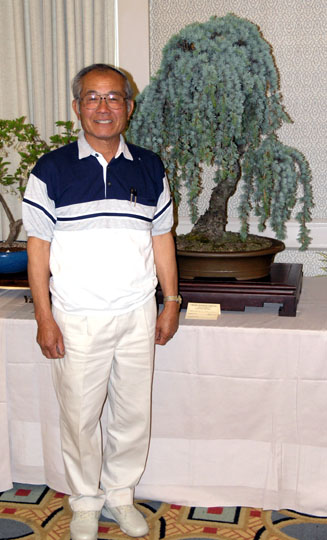
Johnny Uchida with a Blue Atlas Cedar (Cedrus atlantica 'Glauca'), April 24, 2004
(Facebook
post by Bonsai Mike, Nov. 4, 2022; much of this is from
"Johnny Uchida-Kai Sensei," Yamato Bonsai Kai,
which can also be found on Flickr
and BursaBonsai.com;
Beaver, Michelle
"Local
bonsai master leads conference, East Bay Times, October 12, 2005; Cohen, Rachel
Small pleasures:
Bonsai are coming," East Bay Times, October 20, 2006, which gives Yamato's founding date as 1968;
"Yamato Bonsai kai Club," Eden Township Japanese
Community Center, gives the year as 1971; "Yamato Bonsai Kai Newsletter,"
April 2012, pg.
2) SEE ALSO: Feb 20, Mar 4, Mar 31, Apr 7, Apr 25, Jul 28
(Photo courtesy of Alan Walker, 05/11/07) 2023 -- David Weyland Fukumoto passed away peacefully in Hilo, Hawai'i at the age of 83 years. (David born in 1940 in Honolulu and went to Roosevelt High School. He took 3 semesters of engineering at University of Hawai'i at Mānoa, and then was field superintendent for Tom Fujikawa Painting Co. Myrtle Yukie was also born in 1940 but in Olaa, Hawaii, also went to Roosevelt High (class of 1958), and then studied at Honolulu Business College, from where she became a clerk-stenographer for the U.S. Army's Fort Shafter. In 1962 she married David, and they set about growing and training Brassaia (Schefflera) houseplants in their apartment to start pioneering the new innovative field of indoor bonsai. They lived on Myrtle's salary while David's construction painting and other income went into savings. Within a year they purchased a home in Kaneohe and together opened a backyard nursery quickly filled with bonsai. The early years saw David as an early English-speaking bonsai instructor, co-founder of bonsai clubs and the umbrella non-profit Hawaii Bonsai Association (HBA) in 1972. David was the youngest behind-the-scenes supporter of Hawaiian bonsai. The couple developed their bonsai team-teaching curriculum and lesson plans as education committee chairman and course coordinator. David was asked to substitute teach an evening adult education bonsai course at Aiea High School at a time that there was no published tropical bonsai information nor suitable plants in garden shops. Myrtle became a backyard nurserywoman, propagated seeds and cuttings, and maintained a bonsai collection of over 2,000 trees in training. They participated in formulating the Hawaii State Burrowing Nematode Nursery Certification Program (in Honolulu) and, upon approval, moved to the Big Island of Hawaii to form the first such nursery under that program, Fuku-Bonsai in 1973. With the profit from the sale of their home they purchased a 12-acre former sugar cane field, built a new home, and started building the nursery after David worked as a painter during the day and on weekends. A year later they began sales, and two years later the nursery income allowed David to go full-time. They also developed a non-soil media with volcanic pumice with first products utilizing volcanic-welded splatter cinder, and designed and slip-casted bonsai pots with original plaster molds. They refinanced their property and expanded rapidly with operational profits and several loans. A modest 2-bedroom employee cottage was constructed and Myrtle's parents, Rickey and Haruko Kiyabu, became their first employees. From the start, Fuku-Bonsai produced only premium branded products that were direct niche-marketed by mail order or sold by widely-scattered area-exclusive Fuku-Bonsai Authorized Retailers with delivery via U.S. Postal Air Priority Mail protected by a special packing system and with a satisfaction and safe arrival guarantee. In 1974, David's first two articles were published: "Bonsai in Hawaii" in Bonsai Clubs International's Bonsai Magazine and "Island Hopping" in the American Bonsai Society's Journal. The Island Hopping article told of bare rooting and fumigating the bonsai collection to move from Honolulu to the Big Island to meet inter-island plant quarantine requirements. The article was featured at the ABS booth at the July 1974 joint Pasadena convention co-sponsored by the California Bonsai Society, American Bonsai Society, and Bonsai Clubs International. This was the first opportunity to meet Dorothy Young (who later became the editor of the ABS Journal), John Naka, Ed Potter, and many of the early national bonsai pioneers. A sequel article "Successful Island Hopping" included the photo of the dead trunk of one of the few trees that did not survive silhouetted against a sunset which was used as a cover of the Winter 1975 issue. From 1975 to 1979 as a research affiliate of the Harold Lyon Arboretum of the University of Hawaii at Manoa, David amassed over 200 Ficus species and varieties, ran trials, researched, and published a series of articles in the ABS Journal. This is credited with Ficus becoming the most popular American bonsai. But Ficus requires more light than is available in most indoors and the couple shifted research to True Indoor Bonsai™. (Jerry Meislik expanded Ficus research and was the author of FICUS, The Exotic Bonsai in 2004.) Haruko Kiyabu was Fuku-Bonsai's first "Plant Mama" in charge of the potting house. Certified "high-velocity pumice ejecta" was delivered in 30 cubic yard truckloads into a concrete pit, shoveled into their mass screening to separate into coarse bottom and body media. The body media was further screened and mixed with organic matter, fertilizer, etc. for their certified potting media. The Fukumoto's produced enough income by selling 10% of production with large quantities going into the "Old Plant Bank" for bonsai training for future sales. David participated in a Japan Bonsai Tour with the Hawaii Bonsai Association, and he attended the joint ABS/BCI IBC 79 in New York to give a presentation promoting IBC 80 Hawaii. Fuku-Bonsai became the first Hawaii State-certified nursery to ship to Canada and Europe. They designed a line of plastic bonsai pots and saucers manufactured by Ole Orchard Hill of Michigan and later became a designer for a line of larger fiberglass bonsai pots. In 1980 David coordinated and moderated the Hawaii 3-Ring Demonstration at the landmark International Bonsai Convention co-sponsored by the Hawaii Bonsai Association and Bonsai Clubs International at the Sheraton-Waikiki Hotel in Honolulu. Now, in preparation for IBC 80 Hawaii, Japan's grand master Saburō Katō and Hawaii's Haruo "Papa" Kaneshiro came to select Ficus benjamina for the former's "Peace Forest" demonstration. He wanted a tree that would flourish and continue to improve into the future. Over 40 trees were selected to be pre-trained and root-pruned to his specifications. ("Bonsai no Kokoro (The Spirit and Philosophy of Bonsai)" was also presented by Katō-san at IBC 80 Hawaii.) Two Indian Hawthorns (Raphiolepsis indica) were part of a demonstration given by David in 1980 which introduced reduction-building concepts to the Big Island. At that time, the Big Island followed traditional Japanese bonsai methods, and that demonstration led to the forming of the Big Island Bonsai Association the following year on January 23. Fifteen individuals met at Fuku-Bonsai in Kurtistown to form the BIBA as a non-profit group of individuals dedicated to the promotion, advancement, and fellowship of bonsai. David was the secretary-treasurer and course coordinator in the initial year -- leading the two-year project "Revitalization of Bonsai" on the Big Island -- and then was BIBA's third president in 1984. David was an ABS Director in 1985, was part of the editorial committee in 1988-89, and had some 23 articles published in the Journal between 1974 and 96. He was the winner of the BCI Artist, Writer, Photographer Award in 2002, and had some 27 articles published by BCI between 1974 and 2002. He was profiled in Bonsai U.K. in 1991. In June 1985 at the ABS Convention in East Lansing, MI David gave a slide show and lecture, "Bonsai Innovations." He also took part in the July 1986 joint ABS/BCI Convention in Washington, D.C. David then participated in a Chinese Bonsai-Penjing Tour organized by Dorothy and Luther Young of Pennsylvania. He visited and later represented Hong Kong's penjing master Wu Yee-Sun. Their website www.fukubonsai.com dates from the beginning of 1999 and includes many articles by David. On Jan. 1, 1985 Fuku-Bonsai was incorporated to build, own and operate both the 12-acre Kurtistown nursery and a 17-acre Kona Fuku-Bonsai Center as a major international visitor attraction in part of the former Tanaka Quarry in upper Keauhou-Kona, the then developing visitor destination area. Everything related to bonsai went into the corporation with professional appraisals of the 12-acres, improvements, bonsai, inventory, etc. The Fukumotos were the sole initial stockholders. Over the course of nine stock offerings they were joined by more than 200 mostly modest Big Island stockholders and raised over $2 million to fund the Kona Fuku-Bonsai Center. The center featured nine themed bonsai gardens and included extensive educational exhibits. David co-founded the non-profit Mid-Pacific Bonsai Foundation to educate and promote, to be the public guardian of the memorial bonsai of the Hawaii State Bonsai Repository and to be the liaison to the community. The center had a soft opening in 1990 and a formal grand opening in Keauhou, Kona in 1992. Unfortunately, in 1989 Fuku-Bonsai had sprayed its inventory with what turned out to be defective/contaminated Benlate 50DF fungicide. This resulted in the loss of over $30 million for Fuku-Bonsai, forcing a 23-year battle for survival. Damage to the core business from the fungicide necessitated its closing in 1994. ("In 1991, DuPont issued a recall of its Benlate 50DF formula due to suspected contamination with the herbicide atrazine. In the wake of the recall, many US growers blamed Benlate 50DF for destroying millions of dollars' worth of crops. Growers filed over 1,900 damage claims against DuPont, mostly involving ornamental crops in Florida. Subsequent testing by DuPont determined the recalled product was not contaminated with atrazine. The reason for the alleged crop damage was unclear. The Florida Department of Agriculture and Consumer Services suggested Benlate was contaminated with dibutylurea and sulfonylurea herbicides. After several years of legal argument, DuPont paid out about US$750 million in damages and out-of-court settlements. By 1993, a coalition of farm worker and environmental groups came together to form 'Benlate Victims Against DuPont', a group which called for a nationwide boycott of DuPont products. After carrying out tests, DuPont denied Benlate was contaminated with dibutylurea and sulfonylureas and stopped compensation pay-outs. In 1995, a Florida judge rejected a complaint from the Florida Department of Agriculture that had alleged such a link." DuPont was convicted of Racketeering in the Benlate Case in 2001, having known since 1980 that Benlate was an unstable product prone to deterioration in hot, moist conditions and the company had conducted tests in Costa Rica in 1992, but destroyed the records as claims against Benlate mounted. Then in 2006, Costa Rican growers who had also suffered losses won a major court case against DuPont.) By 2011 Fuku-Bonsai was ready to start expansion but were blocked by the economic disaster and recession that followed "9/11". A major computer crash in November 2014 took place, but there was renewed commitment, major computer and website improvements, and progress again. In August 2018 the Fukumoto's began making plans for expansion and started a GoFundMe fund-raiser to raise working capital to complete recovery and start expansion. Unfortunately again, on the night of August 24, 2018 category 4 Hurricane Lane dropped 52" of rain on the Kurtistown watershed and sent a 3' high x +100' wide flash-flood through the low section of the Fuku-Bonsai Cultural Center for several hours. This caused extensive and major damage. Three feet of water in buildings soaked everything and required replacement of phones, computers, printers, and all records. It tore through the nursery potting house, constuction shed, and downstairs storage areas. It completely washed away the sales greenhouse, benches, and salable inventory! But most heartbreaking was the damage to the exhibit collection and the lost of many priceless world-class bonsai. Nevertheless, the Fukumotos reinvented, rebuilt and sought refinancing assistance as private equity investment or private loans. In October 2022 David announced the beginning of a Public-Private Refinance & Restructure Task Force to guide Fuku-Bonsai to evolve into a unique "Semi-Non-Profit Community Benefit Corporation" to benefit bonsai, staff, managers, stockholders, associates, the Big Island community, visitor industry, and economy. They were seeking 200 new large and modest ($2,500 minimum) stockholders who shared their values and were planning a major project of making the Big Island an international bonsai mecca. The first stock offering would raise $500,000 of working capital to bring all accounts current, hire 6-8 "career leadership management trainees" to be mentored and cross-trained to become their core successor management team. A new third Fuku-Bonsai Cultural Center was also planned, costing over $10 million. The initial working capital would be used to make significant progress and profitability, leading to future larger investors. Fuku-Bonsai was envisioned to remain a broad-based Hawaii company to include premium Hawaiian gift product development and unique direct niche marketing. The "Opportunity Campus" might grow to 30 acres and besides the Fuku-Bonsai Cultural Center, it would include interim staff subsidized housing, incubator facilities, and business accelerator capabilities. Then came the devastating Lahaina wildfires of August 8-11, 2023, which caused minor damage to their property and more to that of some neighbors and friends. And less than three months later all of these plans would be put on hold with David's passing. (FB post by Jerry Meislik, Nov. 28; "Fuku-Bonsai Inc"; "BIG ISLAND BONSAI ASSOCIATION'S 25TH ANNIVERSARY ALL-BIG ISLAND BONSAI SHOW!"; "BIG ISLAND BONSAI ASSOCIATION & ALL-BIG ISLAND BONSAI SHOW"; "FUKU-BONSAI RECORD & HISTORY - PART I"; "ABOUT FUKU-BONSAI"; The Indices 2004 ABS, pp. 14, 34, 64; The Indices 2004 BCI, pp. 23, 124, 243; The Indices 2004 BUKE, pg. 28; "Aloha & Welcome to: www.Fukubonsai.com," web,.archive.com capture of Sep 28, 2023) SEE ALSO: Feb 8, Mar 1, May 11, Sep 17, Sep 23, Nov 18, Dec 13 |
|||
| 5 |
1984 -- California teacher Frank Ekizo Iura died at age 88.
(SSN Master File by Birthdate) SEE ALSO: Mar 20, Jun 6
1985 -- The Emperor of Japan bestowed upon bonsai master John Naka the most prestigious award for a non-Japanese citizen, The Fifth Class of the Order of the Rising Sun. (Bonsai Techniques by John Naka, pg. 262 with b&w photo) SEE ALSO: Aug 16, Oct 1, Oct 10
1994 --
Elandan Gardens
opened to the public on six acres of a former landfill for
the City of Bremerton, WA. During the previous three years, over
3,000 cubic yards of sandy fill dirt and over 1,500 tons of granite were
used by three generations of Dan and Diane Robinson's family to create
a landscape of old mossy logs, pristine ponds, waterfalls and streams.
Japanese influences are blended with a recreation of the wilds of the Northwest
surrounded by the Puget Sound. This is the naturalistic setting for creatures
and human visitors to study more than 150 world class bonsai -- maples,
pines, cedars, hemlocks, and cypresses -- from Dan's private collection.
A 3,500 square foot greenhouse has been transformed into a gallery for
rare and unusal plants, bonsai, tools, antiques, gifts and garden arts.
("Elandan Gardens" by Dan Robinson, Bonsai Magazine, BCI, May/June 1996, pp. 16-20;
RJB telephone conversation with Diane Robinson, Apr. 15, 2000; see also
Diane Robinson's "The History and Adventure of elandan Gardens,"
Bonsai Journal, ABS, Spring 2004, pp. 9-10 with 5 color photos)
SEE ALSO: Jan 26
2002 -- The 1st African International Bonsai Convention
started today in Pretoria, South Africa. [Running through the
10th of the month, there were over one thousand bonsai of notable
though not always refined quality on display. Salvatore Liporace
of Italy and Walter Pall of Germany headlined for participants
from Mozambique, Namibia, and South Africa. TV cameras from the
National Television were present during Liporace's overcrowded
workshop.]
("A Grand Bonsai Debut in an Emerging Continent" by Alessandra Cappelletti,
Bonsai Magazine, BCI, March/April 2003, pp. 32-35)
|
|||
| 6 |
1900 -- An auction of "rare and beautiful Japanese floral and arboreal plants, curiously and artistically
trained, imported by the horticultural department of Messrs. Yamanaka & Co., Osaka, Japan, London, New
York and Boston" started today in London. The two-day event included some 300 items. Of these, 81
were Japanese white pine [Pinus parviflora], 74 were compact hinoki cypress [Chamaecyparis obtusa
'Chabo-hiba'], 12 were sago palms [Cycas revoluta], 10 were Podocarpus species,
and 2 were Chinese junipers [Juniperus chinensis]. A 43-page catalogue was produced for the event.
("From Temple to Terrace, The Remarkable Journey of the Oldest Bonsai in
America" by Peter Del Tredici (Jamaica, MA: Arnold Arboretum, Harvard University:
Arnoldia
64/2-3, 2006), pp. 13, 30). SEE ALSO: May 4, May 26, Nov 15
1961 -- British Pathé issued a color with sound video newsreel film entitled "Bonsai Trees" (aka "Bonzai Trees"). [Ian] Melville Clark of London, the leading British authority on these trees, is shown admiring and working on some trees, while his wife is watering/spraying trees including a 200-year-old shimpaku towards the end of the 2:30 minute film. ("Bonsai on the newsreels" posting by Tim Stubbs, 19 July 2010, on the Internet Bonsai Club Forum). SEE ALSO: May 17 1999 -- The Golden State Bonsai Collection-North opened its gates on this date in the Lake Meritt Garden Center, Oakland, CA. This was directly behind the Lakeside Garden Center complex which had been the scene of many bonsai meetings, shows and celebrations since the late 1960s. (The lake itself, created in 1870, marked the opening of the first wildlife refuge in the United States.) The garden was originally conceived by Bill Hashimoto and Toichi Domoto who in the 1970s thought there should be a place to keep these old legacy trees. Gloria Clementson also supported their vision. When she passed away her estate sold her trees to form the seed money to create this bonsai garden. The docent house is named after her. The Golden State Bonsai Federation, whose president at the time was Hideko Metaxas, spearheaded a fundrasing effort to create this garden. Then John North was instrumental with Seiji Shiba to negotiate with the city of Oakland to acquire this land from which this whole garden was built. Construction took place during the mid-1990s. [The rooms would be available to Collection-North when indoor space was required. With Kathy Shaner as curator and Japanese dry stream-type landscape architecture by Jim Ransohoff, the garden would contain donated trees and stones of John Naka, Harry Hirao, Katsumi Kinoshita, and Helen Murakoshi among others, behind the Friends of Mas Imazumi Entry Gate. A stunning California juniper styled by Masahiko Kimura would also be an early resident. Meandering pathways would lead viewers to benches and pedestals displaying about 100 trees rotated out of a collection of about twice that number. Only ten months after opening, as of the end of August, there would have been some 14,030 visitors. See also this List of Trees in the collection.] ("Golden State Bonsai Collection-North Docents Inducted into Hall of Fame" by Chuck Gallagher, Golden Statements, GSBF, November/December 2000, pg. 6; Golden State Bonsai Collection-North, https://web.archive.org/web/20010724190417/http://test.visualwebcasting.com/bonsai/collection.htm ; "Golden State Bonsai Collection-North Lakeside Garden Center" brochure, written and designed by Dorothy Hayden Land, Feb. 23, 1997; "Oakland's Bonsai Park -- Life and Death among Little Trees" by D.M. Roche, New California Media Online, January 14, 2000, https://web.archive.org/web/20010209005125/https://www.ncmonline.com/arts-and-culture/2000-01-14/bonsai.html; "Garden Tour: The Bonsai Garden at Lake Merritt") SEE ALSO: Feb 20, Mar 10, May 19, Nov Also, Dec 24 |
|||
| 7 | 1975 -- Marco Invernizzi was born in Milan, Italy. [He would be inspired by the movie
"The Karate Kid, Part III" ("Karate kid III - la sfida finale," released in Italy 24 Aug 1989)
and his mom would give him a tree at Christmas of 1991. Thus at age 16 his life would change and he would decide to become a bonsai master.
He would obtain a Degree in Master of Art from the private high school "Istituto d'Arte Beato Angelico" in 1992. From 1992 to
1997 he would study under Salvatore Liporace in Milan, working with him almost every day helping him in the daily work at his nursery.
He also would assist Salvatore during demonstrations and workshops all over Europe. In 1993 he would travel for the first time to Japan
for a study trip of two weeks and he would meet for the first time his future Japanese Master, Masahiko Kimura. The following year
Marco would receive a High School Degree in Architecture at the "Istituto d'Arte Beato Angelico" and start college at the
"Accademia di Comunicazione", the second best design school of Europe. In 1995 he would be
selected by the Italian Bonsai Association as its national representative for the first New
European Talent Competition, make a second study trip to Japan, place himself third at the Best Italian Bonsai Demonstrators
Competition, and start to work part time in two nurseries in Italy as a Bonsai Consultant. The year after being a demonstrator
at the Italian Bonsai Congress (1996), Marco would obtain a College degree in Design with a Master in Graphic Design and Industrial
Design and go to Tokyo where he would study under Masahiko Kimura, one of the greatest bonsai masters in the world. For
almost four years Marco would be the first non-Japanese disciple to follow a traditional bonsai apprenticeship. Beginning in
1998 he would write for a number of the specialty magazines. In 2000 he would be the Headliner Demonstrator at the Italian Bonsai
Congress and would repeat this for the next 5 years in a row. He would also be Art Director of the exhibitions there. Since 2001
he would go back to Japan 4-5 times a year to continue his learning path. His first book in Italian about his experience in Japan and
titled To Japan on my bonsai way would be published in 2003. He would make appearances on the most important national
TV, Website and Radio shows and reviews of the book would be published in over 20 national newspapers and magazines. His
convention headlining would occur throughout Europe, South Africa, South America, and North America. In 2006 he would become
"an incredibly nomadic professional bonsai artist" teaching, lecturing and demonstrating on five continents around the world.
After eight years of design study in 2009 his personally-designed tool, Ichiban, weighing
100gm and replacing seven instruments, would be manufactured by reknowned bonsai tool-smith Masakuni III and be introduced to the world
at the World Bonsai Convention in San Juan, PR. The
Marco Invernizzi Bonsai School @ Willowbog Bonsai in the
North East of England would be established, with Marco both as a regular teacher in the studio, and a source of hand-picked Japanese
and European material for their sale benches. See also these Italian video interviews.]
Marco Invernizzi, 06/04.
(Photo courtesy of Alan Walker, 05/11/07) 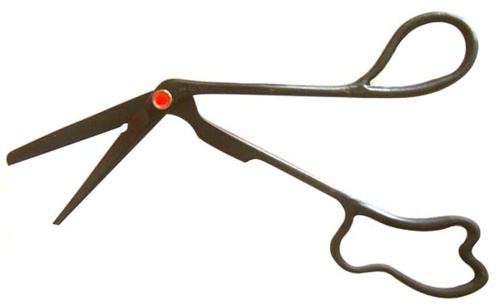
Ichiban bonsai tool.
("Profile,"http://www.marcoinvernizzi.com/index_uk.html;
"Profile: Marco Invernizzi," http://www.artofbonsai.org/forum/viewtopic.php?t=1070%3E;
"Ichiban,"http://www.ichiban.it/.) SEE ALSO: Mar 31, May 15, Oct 15
|
|||
| 8 | 1980 -- The Constitutional Meeting of the Spanish Bonsai Association was organized by Dr. Gustavo Piera with assistance of representatives from seven clubs in five cities meeting in Valencia. The clubs were from Barcelona (3), Madrid (1), Seville (1), Alicante (1), and Valencia (1). ("Club Corner Correction," Bonsai Magazine, BCI, Jan/Feb 1982, pg. 28) | |||
| 9 | 1929 -- Mary Madison was born in Florida. (She would go on to become the "Queen of Buttonwood Bonsai.") SEE ALSO: Jul 28 | |||
| 10 | 1956 -- Starting today and continuing into tomorrow, the Tokyo Bonsai Club met in Ueno, about one month before
the 31st Kokufu kai bonsai exhibition there.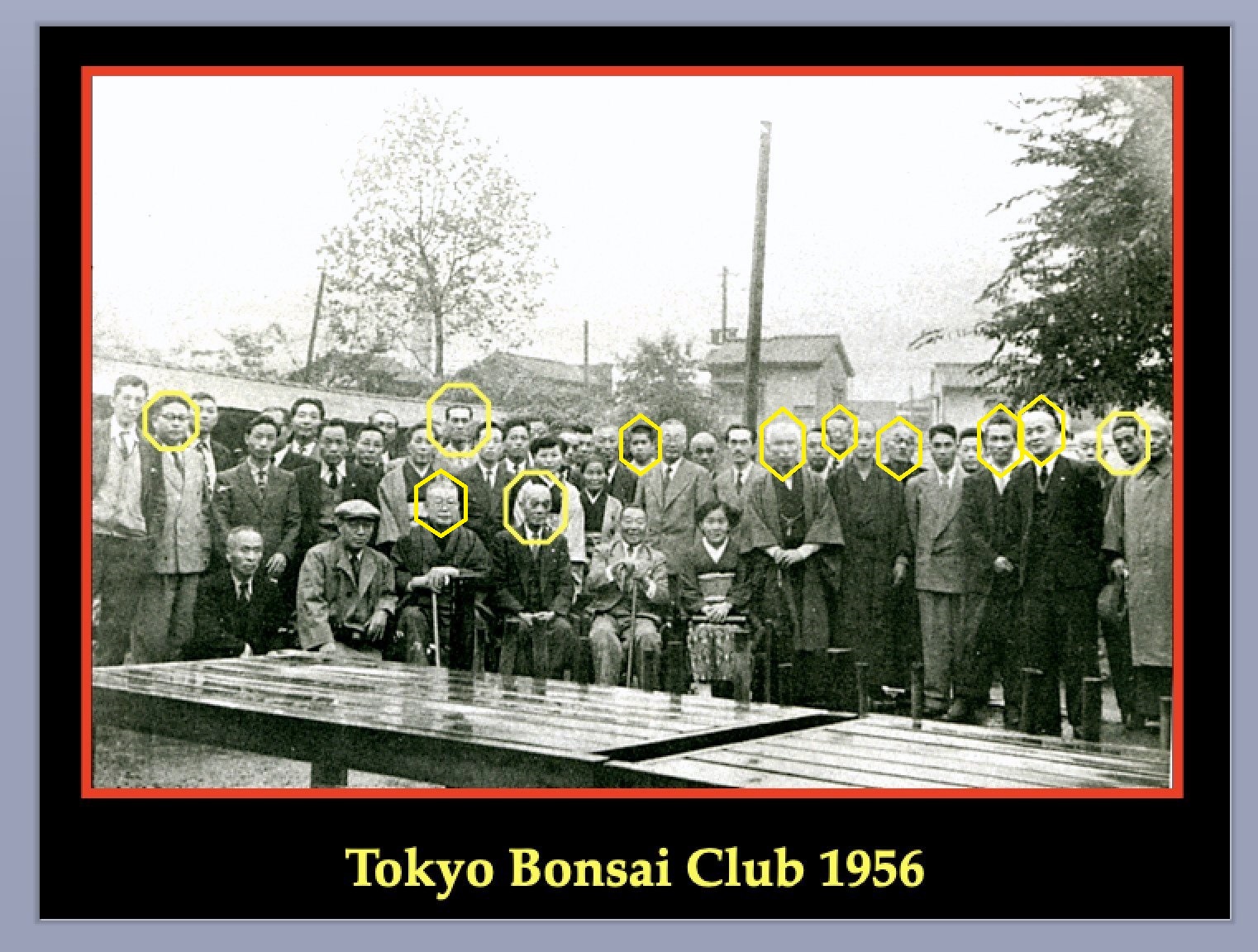
Various individuals identified:
Nobukichi Koide, Mr. Fukunishi, Yuji Yoshimura (1921-1997), Toshiji Yoshimura (1892-1975), Masahiko Kimura (b.1940 - one year into his 11 year apprenticeship under Mr. Hamano!), Tokichi Matsuura (?), Mr. Saida, Mr. Okubo, Motosuke Hamano (?-1991), Toshinori Suzuki (?), and Saburō Katō (1915-2008). Chou Kadokura and his wife are seated in front to the right of Toshiji Yoshimura. (Photo courtesy of William N. Valavanis, octagons, 07/02/19 in private email to RJB; plus original and additional identifications by Adam Webster, hexagons, 06/30/19 and 07/04/19 on posting by RJB of picture from a Japanese-language-only FB friend, a second photo of this gathering taken from a slightly different angle with the below text. A few other named individuals are hidden behind persons in the above photo. Rob Kempinski 07/02/19 on the FB post thread translates the text as: "Photographed at the venue on the day. (Front row Mr. Chou Kadokura and his wife.) The time: November 10-11, Showa 31 (1956) The Place: Ueno Pond at the end of the Tokyo Bonsai Club meeting.") 
cf. This c.1956 video of [sic] Kadokura Mitsuzou's garden in Omiya (which no longer exists). Video is in color from 3:27 mark to 6:23, and from 9:22 to the end (13:31). See also this ten-minute-long video which gives some details about the above photo and video, and shows bus-loads of guests visiting the Kadokura garden. 2014 - Paul Goff died at age 62 following a severe stroke the previous week. (Born in 1952, he enjoyed a life of art and creativity encompassing architecture, rock music, painting, photography, and bonsai. Much of his work was published on video or DVD. He authored many magazine articles, and his photography and illustration talents covered a wide variety of topics. These were featured in commercial literature, journals, periodicals, magazines, books, reference material, and on many websites. He also made a large archive of digital images available to publishers and designers. He worked in oils, watercolours, chalk pastels, and airbrushing.) (Paul began studying and creating bonsai in 1970, and lately he was creating many traditional display arrangements with bonsai, scrolls, and suiseki. His works were featured on television, video, books, magazines, and exhibitions throughout the UK and Europe. In 1994 he co-authored with Harry Tomlinson The Bonsai Year Book. "This is the first book to clearly address the timing of bonsai care and training and includes a detailed month-by-month guide. There are over 160 color photographs that clearly illustrate the steps to be taken and provide inspiration as well. This is an essential companion for seasonal maintenance and care. 96 pages." (DaSu Bonsai Studios). One of his on-line articles is "Considering the placement in a tokonoma" (reprinted from Chapter 6 of Craig Coussins' 2006 book Bonsai Master Class). Another article is "Bonsai presentation; use of Haiku in a Tokonoma display, at Bonsai Empire in 2013. Paul and his partner Viviene were traders (vendors) at several exhibits in the UK. He created beautiful mini scroll sets which were ideal for the smaller bonsai sizes like Mame and Shohin which could be designed and made to individual requirements as well as creating one piece scrolls with fantastic eye catching illustrations. Paul's fantastic scrolls were a regular feature at the former British Shohin Association shows. There were many award-winning exhibits in which one of his scrolls formed an integral part of the design. And he was instrumental in setting up the BSA Show book produced a few years earlier. He was also the official photographer for many bonsai exhibitions and events in Europe and produced several educational videos featuring Harry Tomlinson and Kevin Wilson, including Bonsai: The Danny Use Collection at Ginkgo. Paul presented a demonstration for at least one club in 2011 on how to photograph bonsai. His photos of the trees of The National Bonsai Collection at the Birmingham Botanical Gardens grace that website. As noted by teacher/artist Tony Tickle, Paul "was a true character in the British bonsai scene, flamboyant and hugely talented he was always eager to share his knowledge." For several years he produced a monthly newsletter called The Bonsai Review. His own bonsai website was http://www.bonsaipresentations.com/ and his personal website was http://www.paulgoff.co.uk/.) ("Paul Goff," http://britishshohinbonsai.com/2014/11/14/paul-goff/; "Paul Goff of Bonsai presentations," http://swindon-bonsai.co.uk/2012/12/23/paul-goff-of-bonsai-presentations/; "Paul Goff, Bonsai Display," in September 2007 issue of Billboard, the Newsletter of the Bonsai Society of Upstate New York) SEE ALSO: Mar 2, Apr 6, Jun 29, Nov 22 |
